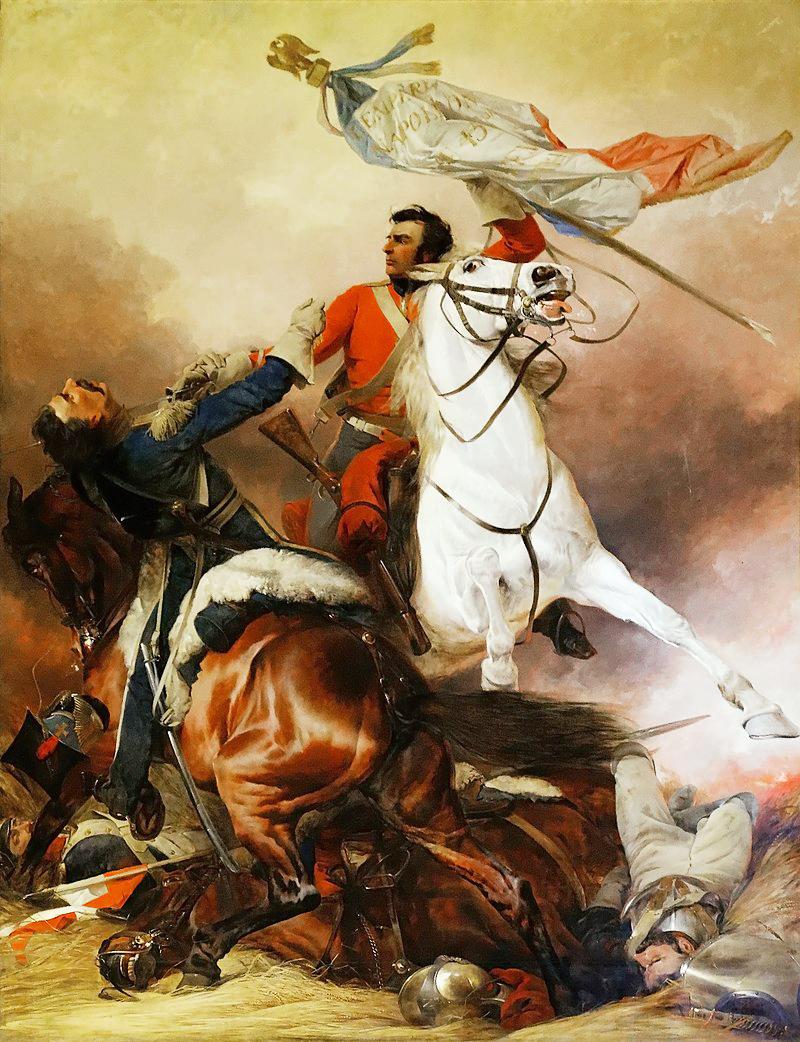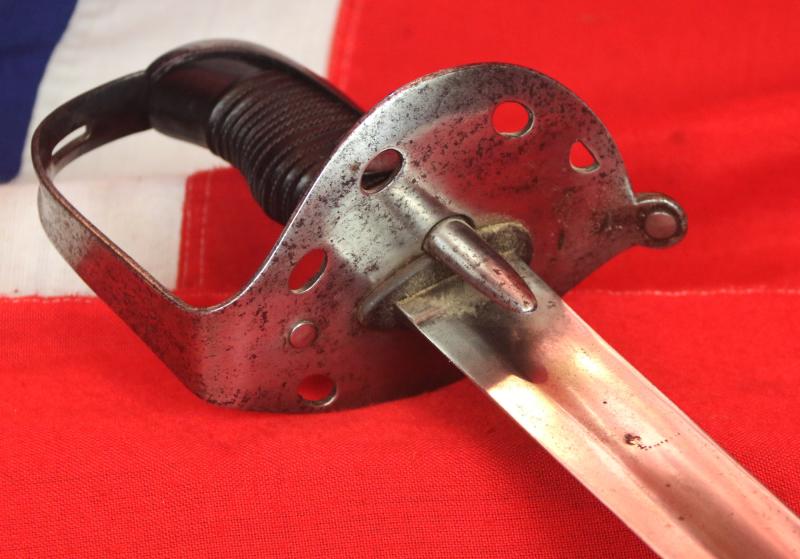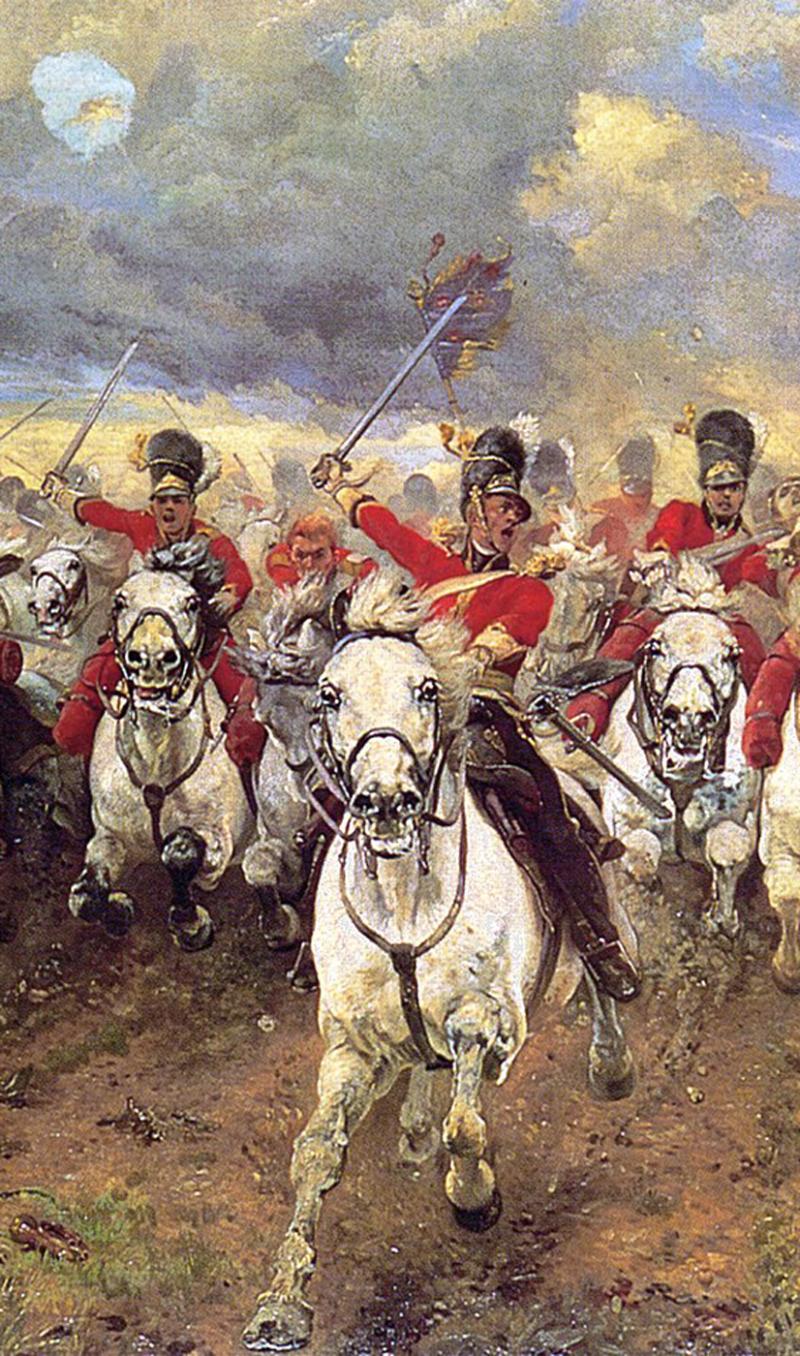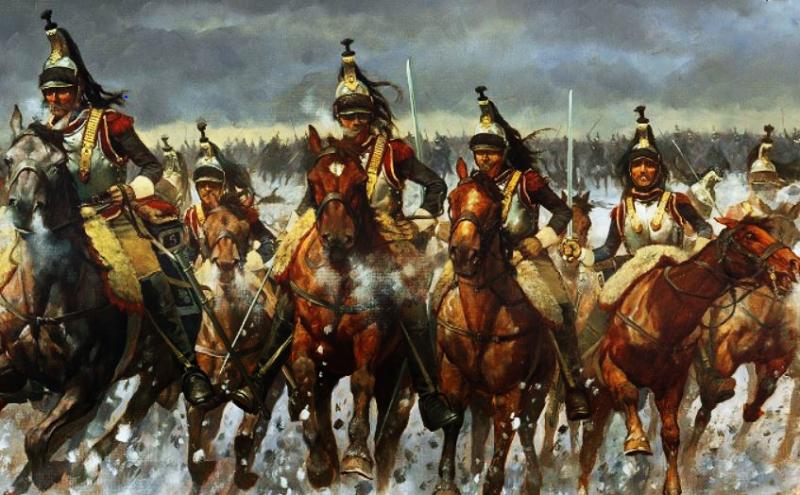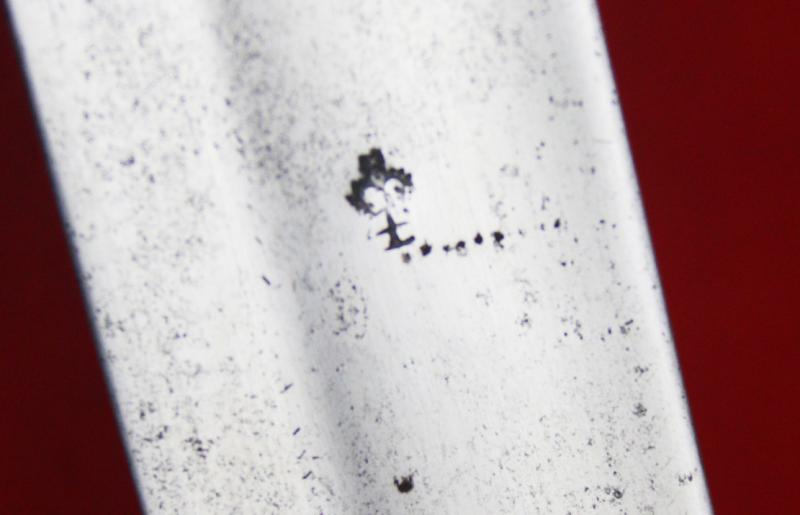A Most Fine 1796 British Heavy Cavalry Trooper's Sword with Ordnance Inspectors Mark. As Used in The Charges of the Union and Household Brigades at Waterloo, Wellington's Victory Over Napoleon in 1815
Overall in superb plus condition, with just feint traces of old minor pitting. Wire bound black leather grip, typical disc guard with two langets, it has its troop number, 'A' engraved, and numbered, '30' on the knuckle-bow. Steel disc hilt, with part of the inner guard removed as recommended at the time, The inner edge of the guard has been trimmed to avoid damaging the uniform, equipment, or digging into the wearer’s side, a modification recorded as early as the late 1790s in some units, spear point blade, maker marked by Dawes of Birmingham.
Photos to add tomorrow.
A few years ago we were delighted to provide for the Tower of London Royal Armouries Collection an identical, original, 1796 H/C troopers sword to be used in Sean Bean’s {he of Sharpe's Rifles fame etc.} documentary on the effective cutting power of both the versions of the 1796 trooper's swords {heavy and light dragoon} at Waterloo.
This is the same form of sword used in the Charge of the Union Brigade, such as by the Scots Greys. Also the Household Brigade, the Ist Life Guards the 2nd Life Guards and the Horse Guards
Both the 1st and 2nd Life Guards were part of Lord Somerset's Household Brigade during the Waterloo campaign and took part in the famous charge of the British Heavy Cavalry against Marshal D'Erlon's infantry corps before being subjected to a severe mauling by French lancers and cuirassiers.
A well-known description of the brutal power of the weapon was made by Sgt. Charles Ewart, 2nd Dragoons (Scots Greys) concerning how he captured an Imperial Eagle at Waterloo:
"It was in the charge I took the eagle off the enemy; he and I had a hard contest for it; he made a thrust at my groin I parried it off and cut him down through the head. After this a lancer came at me; I threw the lance off my right side, and cut him through the chin upwards through the teeth. Next, a foot soldier fired at me, then charged me with his bayonet, which I also had the good luck to parry, and I cut him down through the head; thus ended the contest.
Over 10 years ago we were thrilled to acquire a near identical sword, also lacking scabbard, regimentally marked of an NCO of F Troop who rode right alongside Sgt Ewart of the 2nd Dragoon's, 'the Scots Greys' at Waterloo, when he captured the French Standard. That sword we sold to a private museum collection in Canada
A few years after the dawn of the 19th century, came the culminating battle of the long series of hard fought struggles with the once dominant power of France. In common with the rest of the troops, the Scots Grays suffered all the discomforts of mud, rain, soaked clothing and sodden provisions, before the battle of Waterloo. They took up their position on that eventful day behind the left centre of the line, and they were obliged to wait for a long time in chafing inactivity. A multitude of glittering bayonets and streaming colours came sweeping along in cold phalanxes, preceded by clouds of skirmishers. A division of French infantry outstripping their fellows, charged up into the centre of Wellington's position, and forced the summit of the hill upon which was the Duke. The Greys were moved up to support the infantry who were opposing the French advance. Some of the troops composing the attacking force were Napoleon's Foot Guards, great, big, strapping fellows, hardy old campaigners most of them, who had been with their hitherto invincible leader in numberless battles. The troops that prepared to bar the way were also war-scarred veterans who had fought under the Iron Duke in Spain and Portugal, but who were weaker in numbers than the Frenchmen. To the left of the English regiments was a brigade of German cavalry and light horsemen. When the French Guards came up, they charged these, and made frightful havoc of them, men and horses alike. So shaken were the Prussians that they were broken up and forced to retire. The French then turned their attention to the sturdy English regiments who had formed from square into line in order to receive them.
On came the victorious Guards, flushed with the easy triumph of our allies. This was only one of the many critical moments of the day. Uttering fierce cries of " A bas les Anglais!" they swept along. Our brave fellows were not behind hand in their reply, and a fierce bayonet to bayonet, knee to knee struggle commenced. Sheer weight began to tell - the infantry were shaken- the fight broke up into a series of more or less isolated combats. Suddenly the bugles rang out. Orders were shouted. Some semblance of a line was evolved out of the struggling mass. The psychological moment had arrived. The foot soldiers opened ranks, the squadrons passing through the intervals.
Then their turn came. The gallant Uxbridge gave his orders, which were instantaneously given through the throats of the cavalry trumpets - "Tort! Gallop! Charge!"
Down they charged straight at the face of the opposing columns. The foremost ranks of the enemy were absolutely broken up. Away plunged the Greys into the thickest of the fight. Like a huge grey wave topped with crimson and white, the regiment pierced there way through rank after rank of the French. Load above the roar and din of the battle rose the cry "Scotland for ever!" Along they dashed, encountering masses of the enemy that wellnigh overlapped them. The French infantry broke. The firing ceased; and as the smoke slowly curled away on the damp air, the huge white plumes on the towering bearskins were seen like flashes of foam on a troubled sea of struggling, fighting, ensanguined mobs of men. Numberless deeds of daring and valour during that wonderful ride went unnoticed and unrecorded. A man on foot armed with a rifle and bayonet, is generally accounted a match for any cavalry soldier. But at Waterloo when the big heavy men, knee to knee, on the big heavy grey horses, came tearing down upon the French infantry, they carried all before them. Their opponents, stalwart seasoned old soldiers, scattered and were cut down, ridden over, decimated.
During the fight, Sergeant Charles Ewart performed a glorious feat. As the Greys attacked the 45th regiment of French infantry, Ewart singled out the officer who was carrying the Eagle and rode for him. The Frenchman fought hard. He thrust at Ewart's groin; but the Scotsman parried and cut his opponent through the head. Then a French lancer rode up and attacked him by throwing his lance at him. This too, Ewart parried, and then getting furious, he charged the man, and with a strong sweep of his arm and a dexterous turn of the wrist, cut the lancer from his chin upwards right through his teeth. Another Frenchman then came up, this time a foot soldier, and engaged him with his bayonet. But Ewart soon disposed of him by nearly shearing off his head. After this, the gallant fellow went on, Eagle and all, to follow his comrades, but General Ponsonby stopped him.
"You brave fellow!" said the General. "Take that to the rear. You have done enough until you get quit of it." Ewart obeyed orders, but with the greatest reluctance.
Following up their unprecedented success, the Greys went on, charging everything they came across: Lancers, Cuirassiers, Artillery - little they cared -until they actually penetrated to the rear of the French position. Their glorious valour cost them dear, and it was only by hard, desperate fighting that they regained the British lines and resumed their post only just in time to give their mighty support to their gallant comrades of the 92nd Highlanders. This reckless handful - for there were barely 200 of the 92nd left - charged a column of French about 2,000 strong. With the odds of ten to one against them, these brave fellows never hesitated for a moment. They pierced right into the centre of the French, and when the Greys charged up, the Highlanders broke ranks, and clinging to the horsemen's stirrup leathers, went surging into the mass to the wild skirling of the pipes and the yells of "Scotland for ever!" Infantry and cavalry together destroyed or captured nearly every single man of the opposing force.
Small wonder is it that Napoleon, who was greatly impressed by the excellent maneuvering and swordsmanship of the Greys, exclaimed: "Ces terribles chevaux gris! Comme il travaillent!"Unfortunately, during the big charge, the Union Brigade - the Scots Greys, the Royals and the Inniskillings - encouraged and excited by their success which had attended their gallant efforts, followed up their advantage rather too far. They swept across the plain, making light of the ravine that crossed their path, and captured, but failed to bring off, several batteries. But when they had reached the rear of the enemy's position they were naturally much broken and disorganised. The French, smarting under the havoc caused by the serried ranks of the Heavy Dragoons, regained confidence and fell upon the regiments with a large force of Lancers and Cuirassiers. It was a case of fresh troops against spent ones. Yet our men, breathless and panting from their mighty exertions, with their horses covered with mud, fetlock-deep, proved equal to the occasion. They rallied, like the heroes they were, and though sadly cut up, they fought their way through, literally their path back towards their own lines, but not without heavy losses.
The gallant commander of the brigade, Major-General Sir William Ponsonby, was one of those who rode through the victorious charge, but who never returned. His horse was blown, and on the return hopelessly floundered about in the miry depths in a piece of ploughed land. Despite all the efforts of his men, he was set upon and killed by the French Lancers.
When what remained of the regiment came back in two's and three's in scattered groups, the men resumed their former position, exposed to a heavy fire from the French artillery. Great as the British losses had been, those of Napoleon's splendid army were greater, and the French leader sought to force the issue. Well might Wellington sigh for "Night or Blucher"; for in very truth victory was hanging in the balance. Desperate attempts were continually being made by the enemy's infantry as well as by his cavalry to force the stubborn English foot regiments, stretching across the field in isolated squares, to yield their ground. But with bull-dog tenacity they held on with iron grip. The Greys, in common with the Household Cavalry and the other Heavy Dragoons, were condemned to a time of motionless inactivity, until at length the Duke assumed the offensive. The whole army made a simultaneous advance. The Life Guards and the Blues charged, and then the whole line was ordered to move. The Greys, all that was left of them, with men and horses alike refreshed by the enforced bodily rest, joined in the pursuit. For Napoleon's army gave way; his troops were utterly and entirely broken up and pursued with dreadful effect by the English cavalry, were eventually driven from the field, and the glorious field of Waterloo was won!
For their conspicuous gallantry at Waterloo the Greys were allowed to display the Eagle on their guidons, and "Waterloo" on the plume socket of their bearskin caps. Every officer and man who was present at Waterloo received a silver medal, and was entitled to reckon the action as representing two years toward his pension. Please see two lots of regimental markings. Corporal John Dickson's 1796 HC sword is in the National War Museum and is numbered regimentally the same, but No 57 only six numbers away from the sword we sold numbered 51. There were 51 NCO's and other ranks that served in F troop at Waterloo. This sword has no scabbard. Wire grip replaced at sometime and leather restored.
Code: 25374

